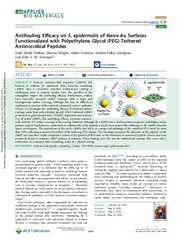| dc.contributor.author | Karlsen, Eskil André | |
| dc.contributor.author | Berglin, Mattias | |
| dc.contributor.author | Hansson, Adam | |
| dc.contributor.author | Lundgren, Anders Oskar | |
| dc.contributor.author | Svendsen, John Sigurd Mjøen | |
| dc.date.accessioned | 2025-08-04T11:53:27Z | |
| dc.date.available | 2025-08-04T11:53:27Z | |
| dc.date.issued | 2025-05-15 | |
| dc.description.abstract | Cationic antimicrobial peptides (cAMPs) kill bacteria in solution by membrane lysis; however, translating cAMPs into a covalently attached antibacterial coating is challenging since it remains unclear how the specifics of the conjugation impact the antifouling efficacy. Furthermore, studies have typically assessed cAMP coatings with a high and homogeneous surface coverage, although this may be difficult to implement in practice of the materials commonly used in medicine. Herein, we investigate the antifouling efficacy of fractional surface coatings made from poly(ethylene glycol) (PEG)-tethered cAMPs presented on gold nanoparticles (AuNPs) deposited onto surfaces. For all tested cAMPs, the antifouling efficacy increases exponentially with the 2D surface coverage of the coating. However, although the cAMPs have a similar primary sequence and display similar potency against <i>Staphylococcus epidermidis</i> in solution, the cyclic peptide is much more potent after tethering to the AuNPs than the linear counterparts. The attachment of the cyclic cAMPs also led to an unexpected shrinkage of the modified PEG-brush by more than 50%, indicating a restricted mobility of the tethering PEG chains. The shrinkage increased the closeness of the peptide on the AuNP and may thus enable cooperative actions of the grafted cAMPs such as the formation of nanosized peptide clusters that were previously found to enhance cAMP potency in solution. These findings pave the way for antibacterial coatings that cover only a subfraction of a material while remaining active in a clinical setting. | en_US |
| dc.identifier.citation | Karlsen, Berglin, Hansson, Lundgren, Svendsen. Antifouling Efficacy on S. epidermidis of Nano-Au Surfaces Functionalized with Polyethylene Glycol (PEG)-Tethered Antimicrobial Peptides. ACS Applied Bio Materials (AABM). 2025 | en_US |
| dc.identifier.cristinID | FRIDAID 2385047 | |
| dc.identifier.doi | 10.1021/acsabm.5c00253 | |
| dc.identifier.issn | 2576-6422 | |
| dc.identifier.uri | https://hdl.handle.net/10037/37898 | |
| dc.language.iso | eng | en_US |
| dc.publisher | ACS Publications | en_US |
| dc.relation.ispartof | Karlsen, E.A. (2025). Towards general and effective antifouling surfaces – covalent surface attachment of antimicrobial peptides. (Doctoral thesis). <a href=https://hdl.handle.net/10037/37899>https://hdl.handle.net/10037/37899</a> | |
| dc.relation.journal | ACS Applied Bio Materials (AABM) | |
| dc.rights.accessRights | openAccess | en_US |
| dc.rights.holder | Copyright 2025 The Author(s) | en_US |
| dc.rights.uri | https://creativecommons.org/licenses/by/4.0 | en_US |
| dc.rights | Attribution 4.0 International (CC BY 4.0) | en_US |
| dc.title | Antifouling Efficacy on S. epidermidis of Nano-Au Surfaces Functionalized with Polyethylene Glycol (PEG)-Tethered Antimicrobial Peptides | en_US |
| dc.type.version | publishedVersion | en_US |
| dc.type | Journal article | en_US |
| dc.type | Tidsskriftartikkel | en_US |


 English
English norsk
norsk
